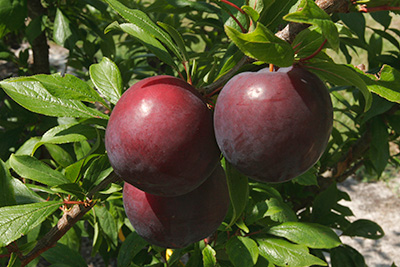Deciduous Fruit Trees

Surprisingly, there are a few deciduous (meaning they lose their leaves in the winter) fruit trees like peach, plum and nectarine suitable to grow in North and Central Florida landscapes. Deciduous fruit trees need a certain amount of exposure to cold winter temperatures each year. This amount varies among cultivars and is called the “chilling requirement.” Be sure to look for the “low chill” cultivars that are better suited to our mild winters.
Peaches and Nectarines
Thanks to careful cultivation, there are varieties of peach and nectarine trees that can be grown successfully in Florida. Cultivars with higher chilling requirements should only be grown in Northwest Florida, but others have been developed for Central and North Florida. See “Florida Peach and Nectarine Varieties” for a full list of recommended varities.
Once your young tree is planted, train it to have an open, soup-bowl shape. After the first two years, prune it twice a year. Trim the tree lightly during the early summer, saving heavy pruning for the dormant season. Look for your fruit to ripen in April or May.
Growing

In North Florida, stone and pome fruit do well. Stone fruit include peaches, nectarines, and plums. They are called stone fruit because they consist of a seed enclosed in a heavy pit surrounded by soft flesh. Pome fruit, such as apples, pears, and the native mayhaw, also do well.
Use the University of Florida recommended plant lists to help you choose varieties that will work best in your area.
Before you buy trees, inspect them for signs of insects, diseases, and other problems. Only bring home healthy trees, and plant them right away in a sunny location.
Container-grown fruit trees may be planted at any time of the year, but December and January are the best months. Select a site near your home to make harvesting easy.
Most fruiting plants should be fertilized in early spring. For success, you should know a little about your crop, choose the right product to do the job, and apply it with the right frequency. Choose quality products that contain micronutrients and apply them at the recommended rate by broadcasting them under the canopy.

Sand Pear
Asian pears, also known as “sand” pears for their slightly gritty texture, are rounder and have a crisper texture than European pears, giving them their other common name, “apple pear.”
Asian pear trees can be grown successfully in North Florida and once established, they’re also drought tolerant. This attractive tree will grow up to thirty feet tall. They like fertile, well-drained soil and full sun. Mulch your tree to help keep moisture in the soil. With regular feeding, it should bear fruit within three years.
Sand pears have firm skin, so it can be hard to tell when they’re ripe. Pick them when they’re full-sized, testing a few first to evaluate their sweetness. The fruit will not ripen any further once picked.
Also on Gardening Solutions
More from UF/IFAS
- Enjoy the Florida Sand Pear–UF/IFAS Blogs Columbia County
- Florida Peach and Nectarine Varieties
- Growing Plums in Florida
- Mayhaw, Crataegus opaca–UF/IFAS Extension Santa Rosa County (PDF)
- Rootstock for Florida Stonefruit
Elsewhere on the Web
This article, The Sand Pear – Pyrus pyrifolia, by Peter Del Tredici in Arnoldia, the quarterly magazine of the Arnold Arboretum at Harvard University is old, but worth a read.
